Experimental and Numerical Flutter Analysis Using Local Piston Theory with Viscous Correction
Abstract
:1. Introduction
2. Methods
2.1. Classical and Local Piston Theories
2.2. Local Piston Theory with Viscous Correction
2.3. Local Piston Theory Considering the 3-Dimensional Effect
2.4. Modified Surface Spline Interpolation
2.5. Generalized State-Space Equation
2.6. Mode Tracking Algorithm
3. Results
3.1. Experiment
3.1.1. Structural Model
3.1.2. Ground Vibration Test
3.1.3. Wind Tunnel Test
3.2. Numerical Analysis
3.2.1. Effective Shape of VLPT
- For all AOAs, . The lower surface of the fin is windward, and so there is a positive pressure difference on the lower surface and a negative pressure difference on the upper surface (shown in Figure 12). The lower boundary layer acquires energy from the external inviscid flow more easily than the upper surface, and the lower kinetic energy loss contributes to the thinner boundary layer.
- With an increasing AOA, the increases and the decreases. As shown in Figure 12, when the AOA increases, the pressure on the upper surface of the fin decreases, and thus the energy loss in the upper boundary layer becomes easier, resulting in an increasingly smaller ; however, the case of the lower surface is the opposite.
- The changes very little at high AOAs. The steady flow streamlines at different AOAs are shown in Figure 13. On the upper surface of the fin, there is a spanwise flow converging toward the midpoint of the trailing edge when AOA < 10°, and it gradually develops into a spanwise vortex when AOA ≥ 10°. It can be deduced that before the formation of the spanwise vortex, wherein the AOAs are 6° and 8°, the increasing AOA contributes to the spanwise flow, causing energy loss in the boundary layer of the root trailing edge. As such, apparently changes with the variation in AOA. After the formation of the spanwise vortex, wherein the AOAs are 10°, 12° and 15°, the spanwise vortex generates an additional downwash that provides the flow energy for the boundary layer, meaning that changes very little with the variation in the AOA.
3.2.2. Flutter Analysis Using VLPT
3.2.3. Flutter Analysis Using LPT
4. Discussion
- There is good consistency shown among the results of different methods. With increasing AOA, the variations in flutter frequencies and the relative errors in the flutter frequencies of different methods are negligible. It is deduced that the small errors between the numerical flutter speeds and test flutter speeds come from the modeling deviation whereby the CFD model does not contain the cavity (marked in red in Figure 8a) on the wind tunnel wall and the gap between the fin root and the wind tunnel wall, resulting in the near-wall flow field and leakage not being simulated accurately enough.
- Compared to the test results, VLPT gives smaller and better results than LPT. There is an obvious decreasing trend in the test flutter speed with increasing AOA, and VLPT imitates this trend. However, the reduction in LPT flutter speed is limited because its steady flow fields at different AOAs are relatively similar. Figure 16 shows the steady flow fields of the LPT at AOAs of 6° and 15°, which contain similar patterns of streamlines and vortices. In comparison to Figure 13, there is no obvious transformation from spanwise flow into a spanwise vortex, which indicates that the spanwise flow and vortex are key to flutter analysis at high AOAs and that the precision of the LPT/VLPT significantly depends on the accuracy of the steady flow results.
- Notably, Zona-Zaero can only perform the flutter analysis at an AOA of 0° and it shows the first bending mode as the crossing mode, which is the same results as that shown Figure 14b. Generally, the flutter speed obtained using Zona-Zaero is conservative, which indicates that the actual flutter speed is higher. At an AOA of 0°, compared to the Zona-Zaero flutter speed, the VLPT flutter speed is higher while the LPT flutter speed is lower, which reinforces the conclusion that the VLPT gives more accurate flutter results than the LPT.
5. Conclusions
- The local piston theory with viscous correction (VLPT) is enhanced to incorporate the 3-dimensional effect, which is capable of accounting for the aerodynamic nonlinearity at high AOAs using steady flow data from CFD analyses. The applicability of the surface spline interpolation has been augmented through coordinate transformation, effectively addressing the singularity issue. Using the contribution of explicit aerodynamic force expression and interpolation techniques, the tightly coupled state-space equation of the aeroelastic dynamic system is derived. Additionally, a flutter analysis scheme built upon a mode tracking algorithm rooted in first-order continuity is established. In comparison with the full-order fluid–structure interaction models, such as the time-marching CFD-CSD coupling, only the steady CFD computational complexity is considered in the presented state-space model, circumventing prolonged unsteady CFD computations. The established aeroelastic analysis method gives consistent flutter results with the wind tunnel test, affirming its proficiency in both linear and nonlinear flutter predictions.
- At the trailing edge of the fin root, the boundary layer on its upper surface is thicker than its counterpart below. When the AOA increases, the upper displacement thickness increases with a concurrent reduction in pressure. The opposite trend is observed for the lower surface. At diminished AOAs, evident variations in displacement thickness occur. These are attributable to the augmenting AOA fostering spanwise flow, resulting in energy dissipation in the boundary layer. At high AOAs, however, alterations in upper displacement thickness are marginal, which can be attributed to the emergence of a spanwise vortex that induces supplemental downwash, subsequently replenishing the boundary layer’s energy.
- Given the fin’s current design, an increase in AOA correlates with a descent in flutter speed, while the flutter frequency remains largely unchanged. In terms of precision, VLPT outperforms the local piston theory (LPT), especially in predicting the downturn in flutter speed. This superior performance can be attributed to VLPT’s more nuanced and precise representation of steady flow features, such as spanwise flow deviations and vortex formations across diverse AOAs. Such observations underscore the pivotal role of spanwise flow and vortices in high-AOA flutter analysis, stressing that the efficacy of LPT/VLPT is heavily contingent on the fidelity of steady flow outputs.
Author Contributions
Funding
Data Availability Statement
Conflicts of Interest
Nomenclature
| Symbols | Definition |
| Pressure | |
| Sound speed/viscous coefficient | |
| Ratio of specific heat | |
| Downwash speed/flow velocity component | |
| Air density | |
| Displacement thickness | |
| Mach number | |
| Unit Reynolds number | |
| Longitudinal distance | |
| Vorticity vector | |
| Velocity vector | |
| Flow velocity component | |
| i, j, k | Unit vectors along the x, y, z axes |
| Vorticity criterion | |
| Viscous coefficients | |
| Reference length | |
| Freestream speed | |
| Reference temperature | |
| Freestream temperature | |
| Wall temperature | |
| Outer normal vector | |
| Time | |
| Displacement vector | |
| Flow speed | |
| Components of the local flow velocity | |
| Components of the effective flow velocity | |
| Local flow speed | |
| Interpolation matrix | |
| Force vector | |
| Coordinate vectors in m-dimensional space and n-dimensional space | |
| Coordinate transformation matrix | |
| Mode shape matrix | |
| Generalized coordinate vector | |
| Generalized mass matrix | |
| Generalized stiffness matrix | |
| Generalized aerodynamic force vector | |
| Generalized aerodynamic influence coefficient matrices | |
| Aera matrix | |
| Pressure matrix | |
| Density matrix | |
| Sound speed matrix/eigenvalue coefficient vector | |
| Matrices of flow velocity components | |
| State vector | |
| State-space matrices | |
| Identity matrix | |
| Null matrix | |
| Flight speed/flow velocity component | |
| Eigenvalue | |
| Eigenvalue vector | |
| Predicted eigenvalue vector | |
| Flutter dynamic pressure | |
| Flutter frequency | |
| Equivalent flutter speed | |
| Air density at sea level | |
| Y-plus | |
| Reynolds number | |
| Upper and lower displacement thicknesses | |
| Pressure difference | |
| Maximum relative error | |
| Subscripts | |
| Freestream | |
| L | Local flow |
| e | Effective flow |
| Normal direction | |
| x, y, z | Axes of global coordinate system |
| , , | Axes of local coordinate system |
| a | Aerodynamic grid |
| s | Structure grid |
| Counter of elements/counter of mode orders | |
| , | Counters of mode orders |
| Superscripts | |
| Counter of flight speeds | |
| Abbreviations | |
| AOA | Angle of attack |
| CFD | Computational fluid dynamics |
| N-S | Navier–Stokes |
| CSD | Computational structural dynamics |
| CPT | Classical piston theory |
| LPT | Local piston theory |
| VLPT | Local piston theory with viscous correction |
| AIC | Generalized aerodynamic influence coefficient |
| FE | Finite element |
References
- Hodges, D.H.; Pierce, G.A. Introduction to Structural Dynamics and Aeroelasticity, 2nd ed.; Cambridge University Press: Cambridge, UK, 2011; pp. 1–247. [Google Scholar]
- Yates, E.C.; Bennett, R.M. Analysis of Supersonic-Hypersonic Flutter of Lifting Surfaces at Angle of Attack. J. Aircr. 1972, 9, 481–489. [Google Scholar] [CrossRef]
- Schuster, D.M.; Liu, D.D.; Huttsell, L.J. Computational Aeroelasticity: Success, Progress, Challenge. J. Aircr. 2003, 40, 843–856. [Google Scholar] [CrossRef]
- Lighthill, M.J. Oscillating Airfoils at High Mach Number. J. Aeronaut. Sci. 1953, 20, 402–406. [Google Scholar] [CrossRef]
- Dyke, M.D.V. A Study of Second-Order Supersonic Flow Theory; California Institute of Technology: Washington, DC, USA, 1951; pp. 1–73. [Google Scholar]
- Jones, J.G. Shock-Expansion Theory and Simple Wave Perturbation. J. Fluid Mech. 1963, 17, 506–512. [Google Scholar] [CrossRef]
- Jaslow, H. Aerodynamic Relationships Inherent in Newtonian Impact Theory. AIAA J. 1968, 6, 608–612. [Google Scholar] [CrossRef]
- Chen, P.C.; Liu, D.D. Unified Hypersonic/supersonic Panel Method for Aeroelastic Applications to Arbitrary Bodies. J. Aircr. 2002, 39, 499–506. [Google Scholar] [CrossRef]
- McNamara, J.J.; Friedmann, P.P. Aeroelastic and Aerothermoelastic Analysis in Hypersonic Flow: Past, Present, and Future. AIAA J. 2011, 49, 1089–1122. [Google Scholar] [CrossRef]
- Meijer, M.C.; Dala, L. Generalized Formulation and Review of Piston Theory for Airfoils. AIAA J. 2016, 54, 17–27. [Google Scholar] [CrossRef]
- Wang, X.; Yang, Z.; Zhang, G.; Xu, X. A Combined Energy Method for Flutter Instability Analysis of Weakly Damped Panels in Supersonic Airflow. Mathematics 2021, 9, 1090. [Google Scholar] [CrossRef]
- Zhu, Y.C.; Yao, G.F.; Wang, M.; Gao, K.Y.; Hou, Q. A New Pre-Stretching Method to Increase Critical Flutter Dynamic Pressure of Heated Panel in Supersonic Airflow. Mathematics 2022, 10, 4506. [Google Scholar] [CrossRef]
- Chen, J.; Han, R.; Liu, D.; Zhang, W. Active Flutter Suppression and Aeroelastic Response of Functionally Graded Multilayer Graphene Nanoplatelet Reinforced Plates with Piezoelectric Patch. Appl. Sci. 2022, 12, 1244. [Google Scholar] [CrossRef]
- Zhang, J.; Yan, Z.; Xia, L. Vibration and Flutter of a Honeycomb Sandwich Plate with Zero Poisson’s Ratio. Mathematics 2021, 9, 2528. [Google Scholar] [CrossRef]
- Zhang, W.W.; Ye, Z.Y.; Zhang, C.A.; Liu, F. Supersonic Flutter Analysis Based on a Local Piston Theory. AIAA J. 2009, 47, 2321–2328. [Google Scholar] [CrossRef]
- Meijer, M.C.; Dala, L. Role of Higher-Order Terms in Local Piston Theory. J. Aircr. 2019, 56, 388–391. [Google Scholar] [CrossRef]
- Han, H.; Zhang, C.A.; Wang, F. An Approximate Model of Unsteady Aerodynamics for Hypersonic Problems at High Altitude. Chin. J. Theor. Appl. Mech. 2013, 45, 690–698. [Google Scholar] [CrossRef]
- Liu, W.; Zhang, C.A.; Han, H.Q.; Wang, F.M. Local Piston Theory with Viscous Correction and Its Application. AIAA J. 2017, 55, 942–954. [Google Scholar] [CrossRef]
- Liu, W.; Zhang, C.A.; Wang, F.M. Modification of Hypersonic Waveriders by Vorticity-based Boundary Layer Displacement Thickness Determination Method. Aerosp. Sci. Technol. 2018, 75, 200–214. [Google Scholar] [CrossRef]
- Liu, W.; Zhang, C.A.; Wang, F.M.; Ye, Z.Y. Design and Optimization Method for Hypersonic Quasi-Waverider. AIAA J. 2020, 58, 2132–2146. [Google Scholar] [CrossRef]
- Chawla, J.P. Aeroelastic Instability at High Mach Number. J. Aeronaut. Sci. 1958, 25, 246–258. [Google Scholar] [CrossRef]
- Zhang, X.; Wang, Y.; Feng, X.; Li, Y. Dynamic Damage Analysis of Airfoil Flutter for a Generic Hypersonic Flight Vehicle. J. Vib. Control 2019, 25, 2423–2434. [Google Scholar] [CrossRef]
- Hunter, J.P.; Arena, A.S. An Efficient Method for Time-marching Supersonic Flutter Predictions Using CFD. In Proceedings of the 35th Aerospace Sciences Meeting and Exhibit, Reno, NV, USA, 6–9 January 1997; pp. 1–10. [Google Scholar]
- Hui, W.H.; Liu, D.D. Unsteady Unified Hypersonic-Supersonic Aerodynamics: Analytical and Expedient Methods for Stability and Aeroelasticity. In Proceedings of the 44th AIAA/ASME/ASCE/AHS/ASC Structures, Structural Dynamics, and Materials Conference, Norfolk, VA, USA, 7–10 April 2003; pp. 1–18. [Google Scholar]
- Hui, W.H.; Platzer, M.F.; Youroukos, E. Oscillating Supersonic/hypersonic Wings at High Incidence. AIAA J. 1982, 20, 299–304. [Google Scholar] [CrossRef]
- Firouz-Abadi, R.D.; Alavi, S.M. Effect of Thickness and Angle-of-attack on the Aeroelastic Stability of Supersonic Fins. Aeronaut. J. 2016, 116, 777–792. [Google Scholar] [CrossRef]
- Shi, X.; Tang, G.; Yang, B.; Li, H. Supersonic Flutter Analysis of Vehicles at Incidence Based on Local Piston Theory. J. Aircr. 2012, 49, 333–337. [Google Scholar] [CrossRef]
- Yang, B.; Song, W. Supersonic Flutter Calculation of a Wing with Attack Angle by Local Flow Piston Theory. J. Vib. Shock 1995, 2, 60–63. [Google Scholar]
- Wang, L.; Wang, Y.; Nangong, Z. Application of Piston Theory and its Improved Methods to the Analysis of Supersonic Wing Flutter. Missiles Space Veh. 2011, 4, 13–17. [Google Scholar]
- Fan, Z.; Yang, Y. Method to Analyse Flutter of Hypersonic Wing with Attack Angle. J. Vib. Shock 2005, 24, 67–69. [Google Scholar] [CrossRef]
- Liu, Q.; Lei, J.; Yu, Y.; Yin, J. Aeroelastic Response of Spinning Projectiles with Large Slenderness Ratio at Supersonic Speed. Aerospace 2023, 10, 646. [Google Scholar] [CrossRef]
- Anderson, J.D. Hypersonic and High-Temperature Gas Dynamics, 2nd ed.; AIAA: Reston, VA, USA, 2006. [Google Scholar]
- Liu, C.; Xie, C.; Yan, Y.; Man, Y.; Zhang, M.; Yang, H. An Engineering Analysis for Panel Flutter of a Supersonic Inlet. In Proceedings of the International Forum on Aeroelasticity and Structural Dynamics 2019, IFASD 2019, Savannah, Georgia, 10–13 June 2019. [Google Scholar]
- Xie, C.C.; Yang, C. Surface Splines Ggeneralization and Large Deflection Interpolation. J. Aircr. 2007, 44, 1024–1026. [Google Scholar] [CrossRef]
- Xie, C.; Hu, W.; Yang, C. Eigenvalue Sorting Problem in Flutter Analysis. Math. Pract. Theory 2007, 37, 141–146. [Google Scholar]
- He, H.N.; Tang, H.; Yu, K.P.; Li, J.Z.; Yang, N.; Zhang, X.L. Nonlinear Aeroelastic Analysis of the Folding Fin with Freeplay under Thermal Environment. Chin. J. Aeronaut. 2020, 33, 2357–2371. [Google Scholar] [CrossRef]

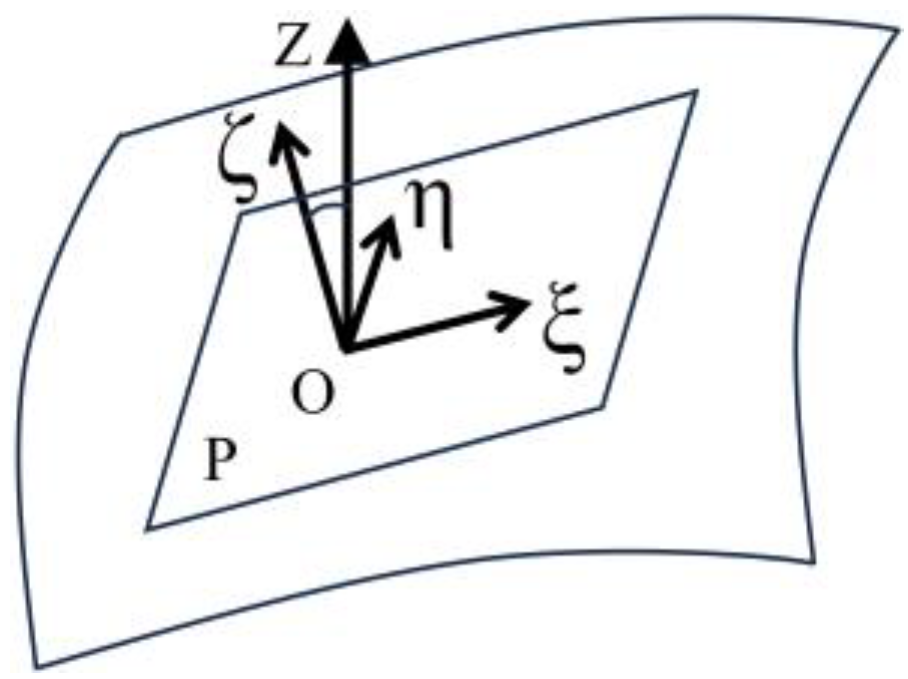




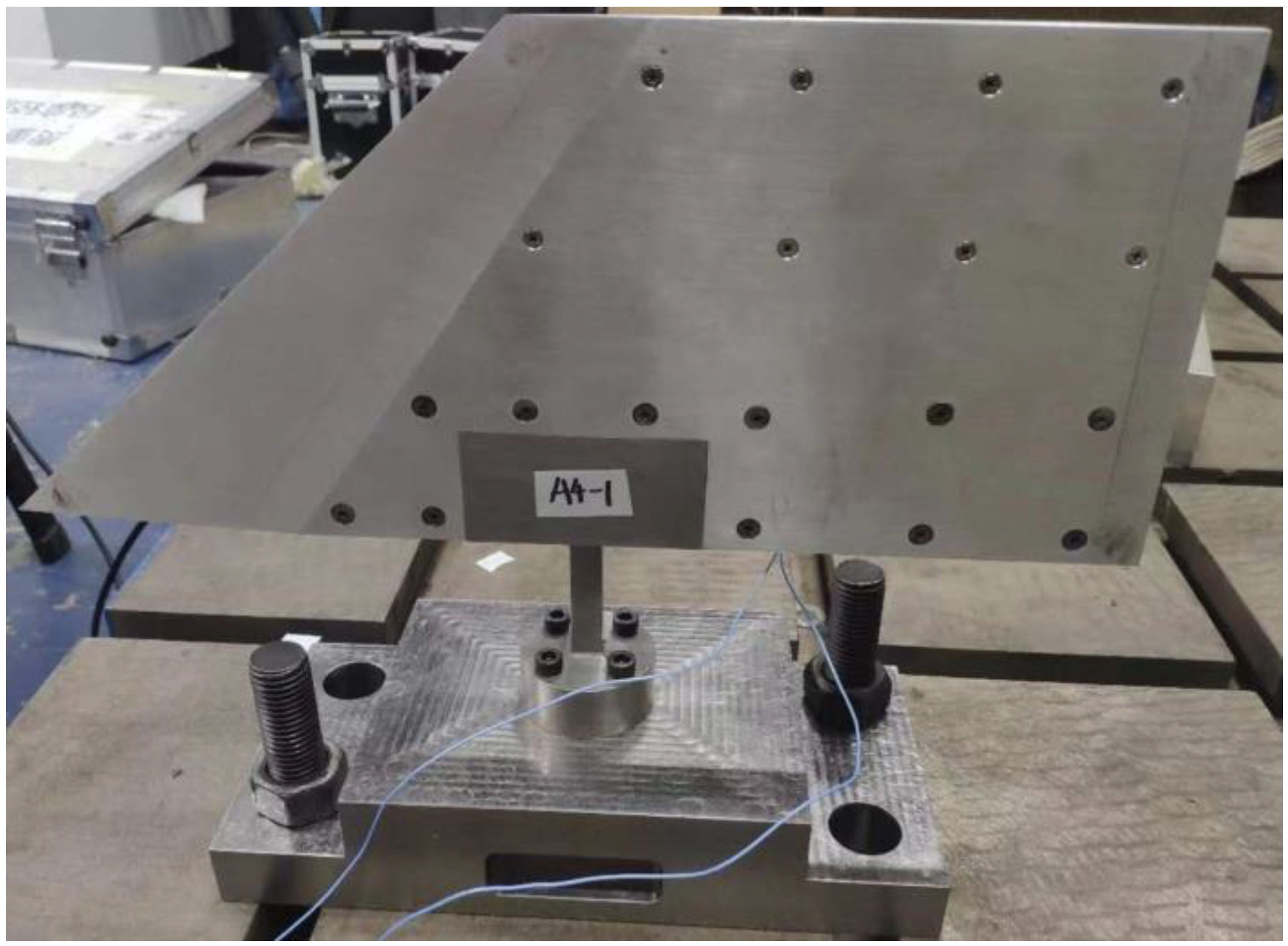
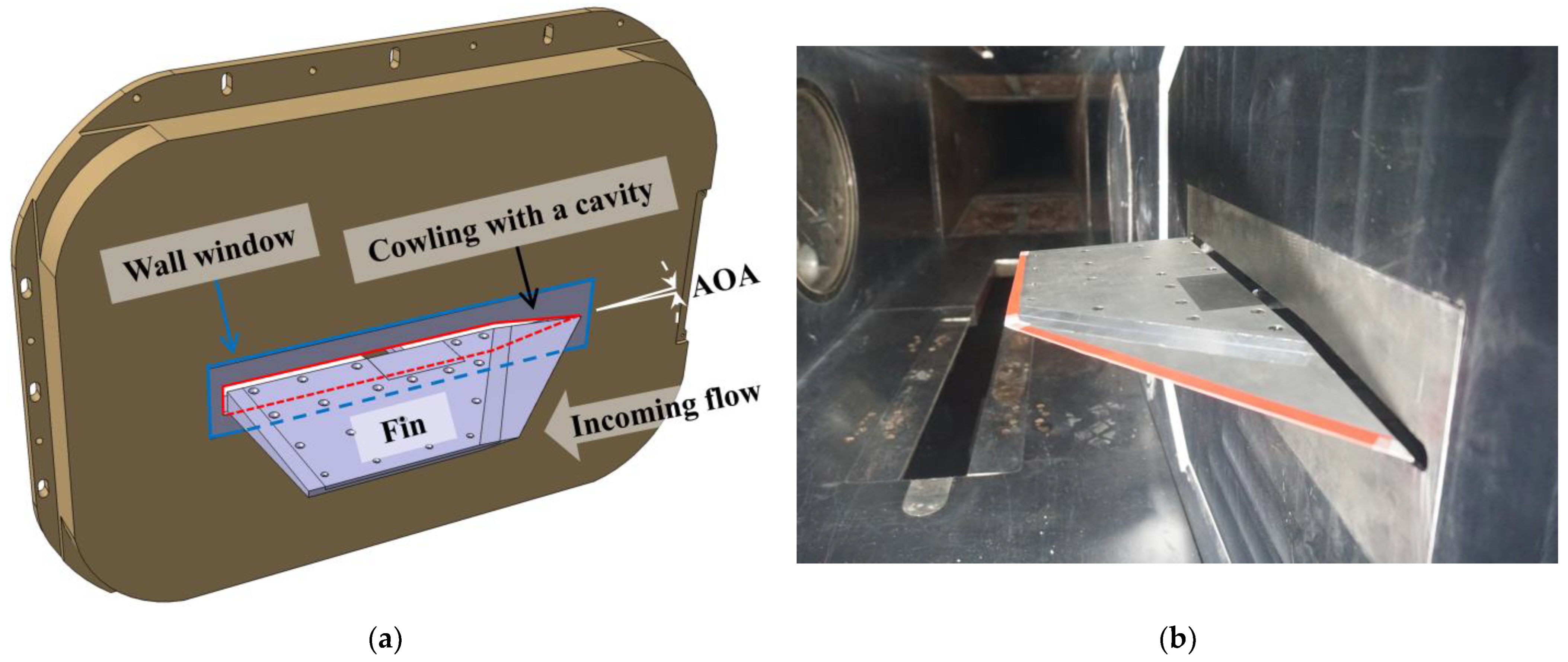
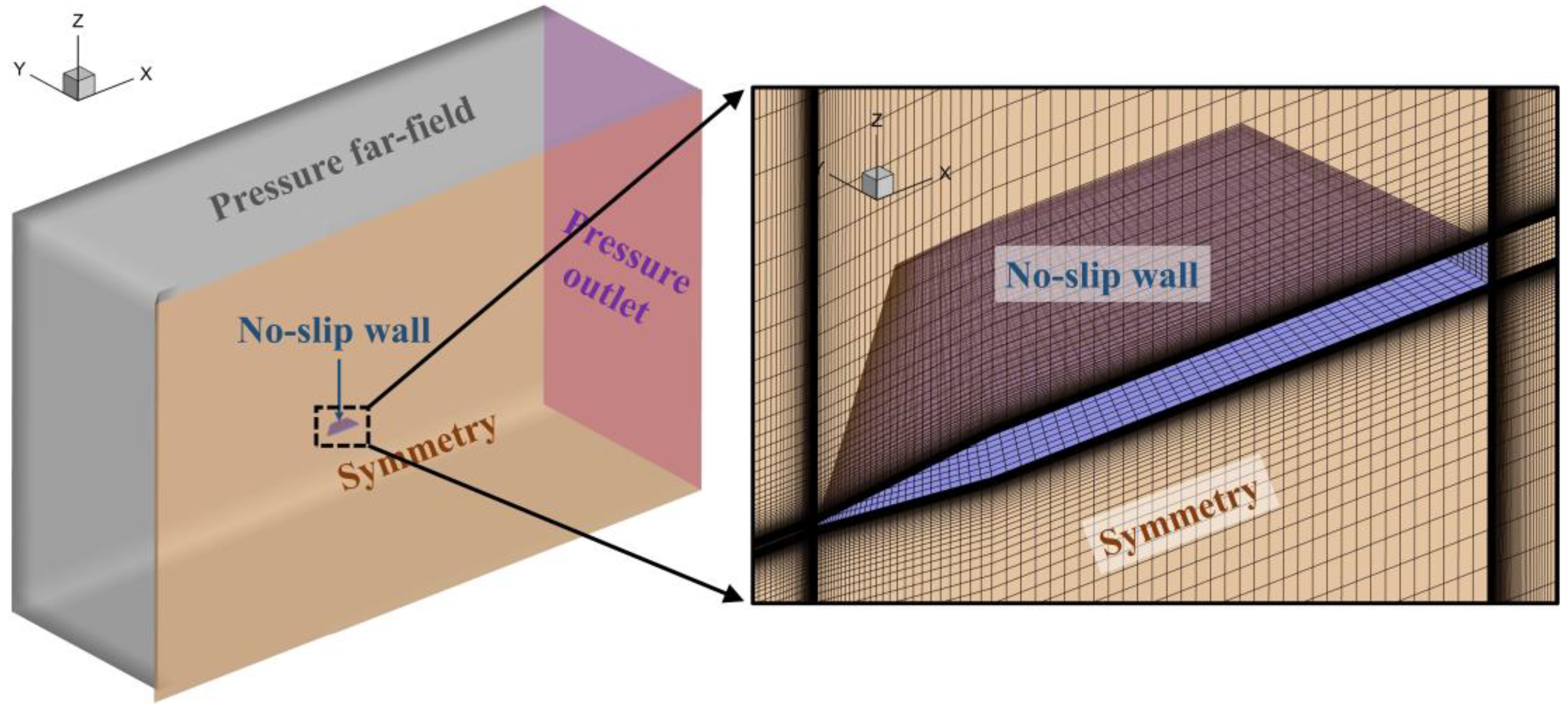

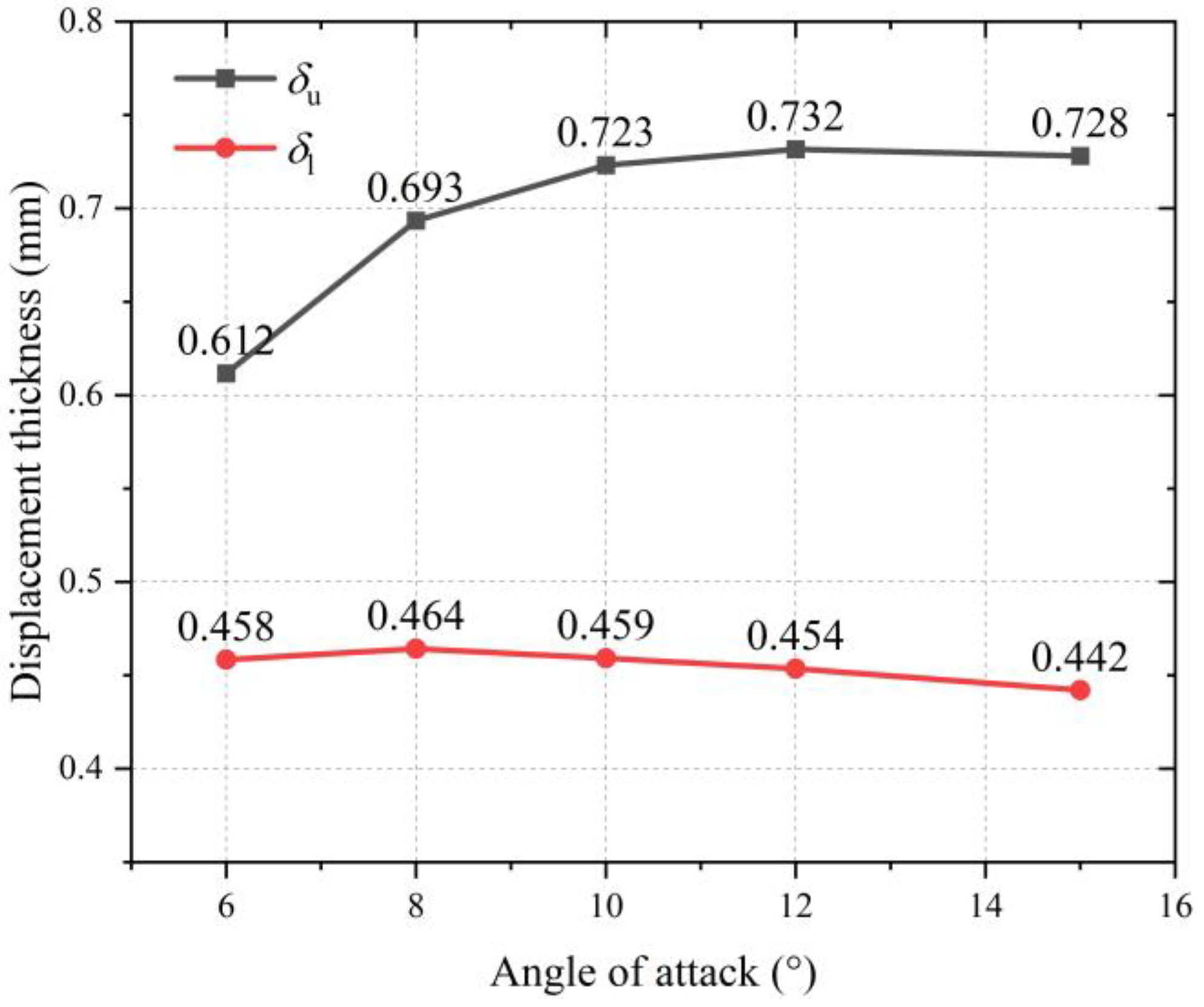

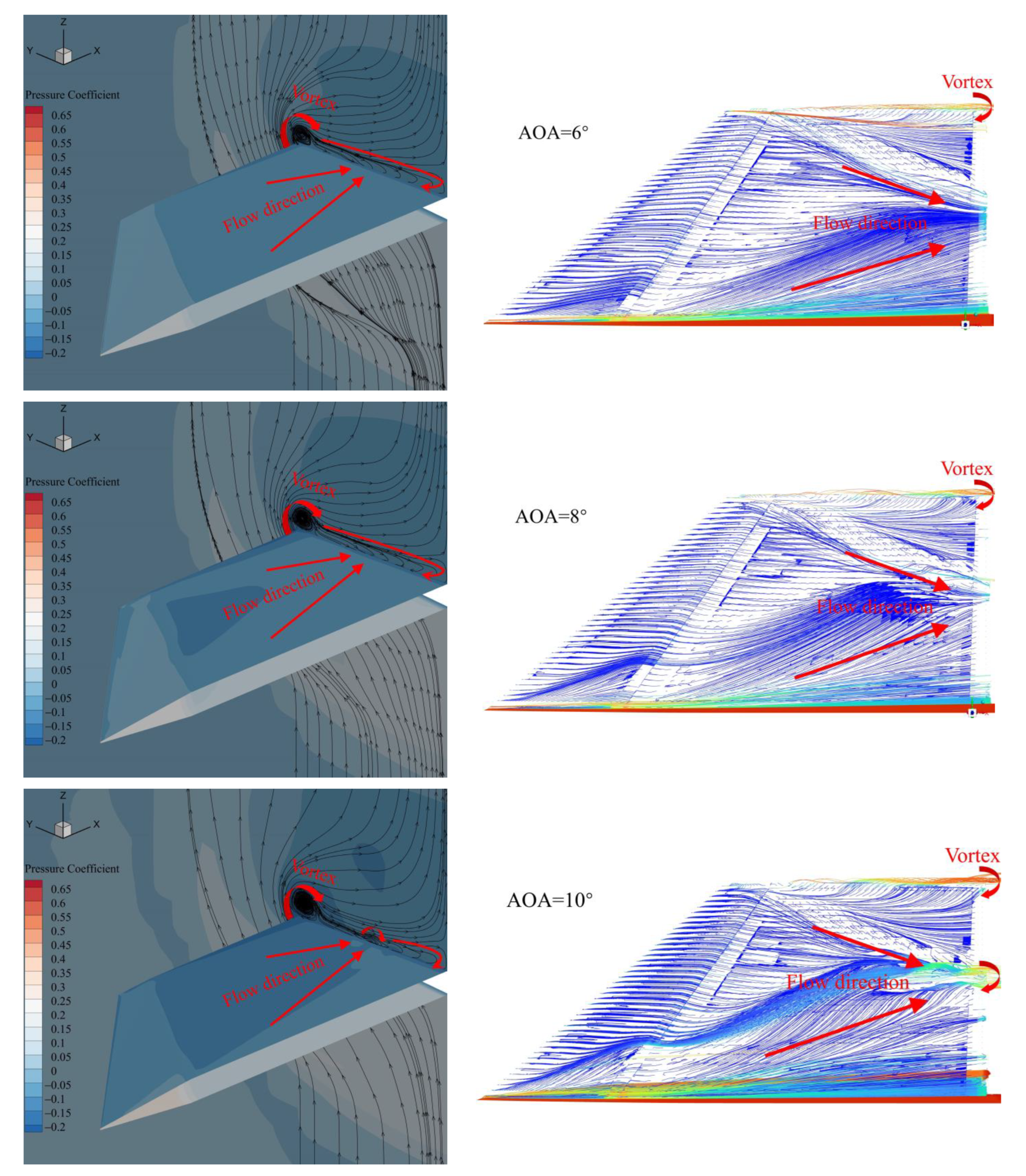
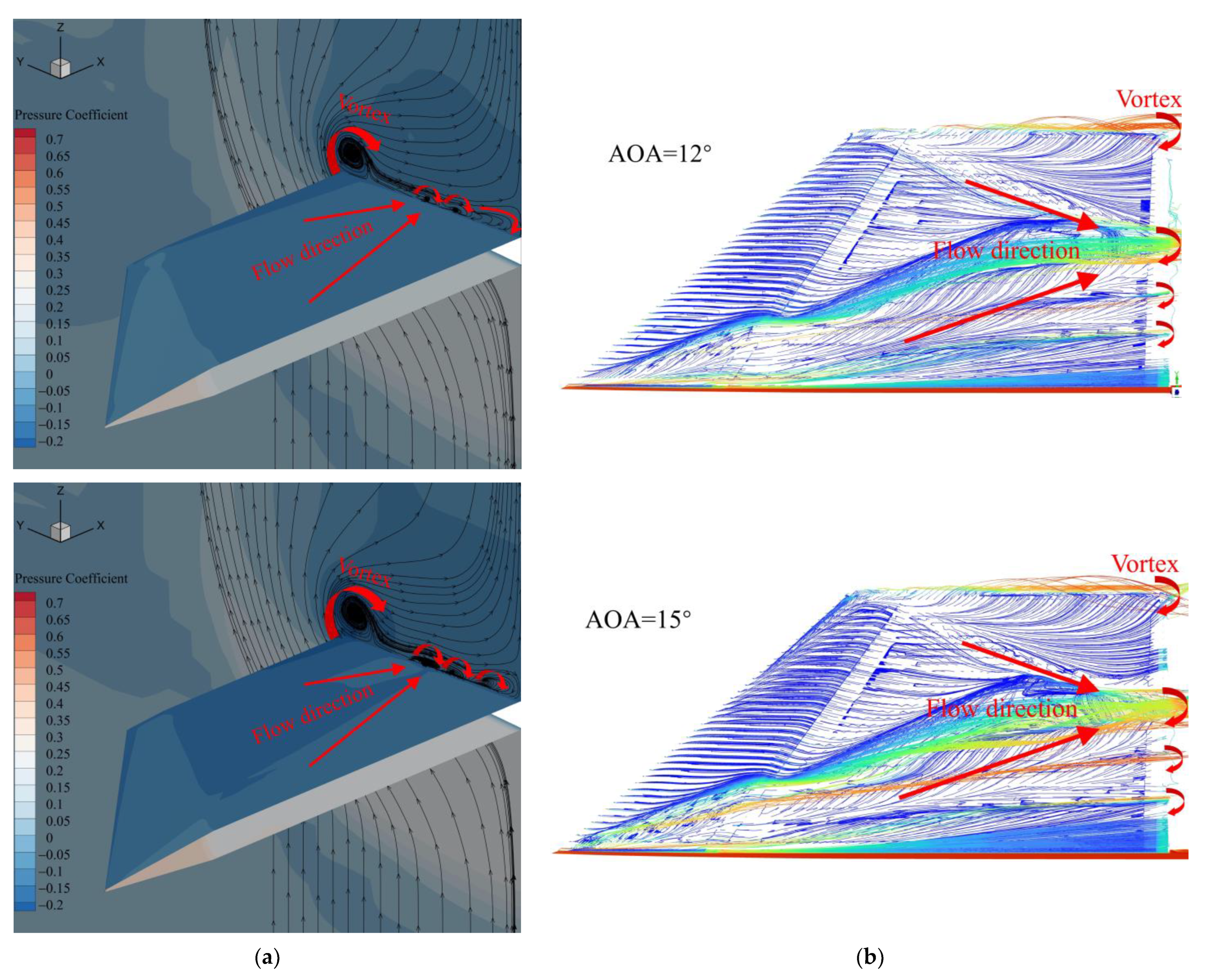

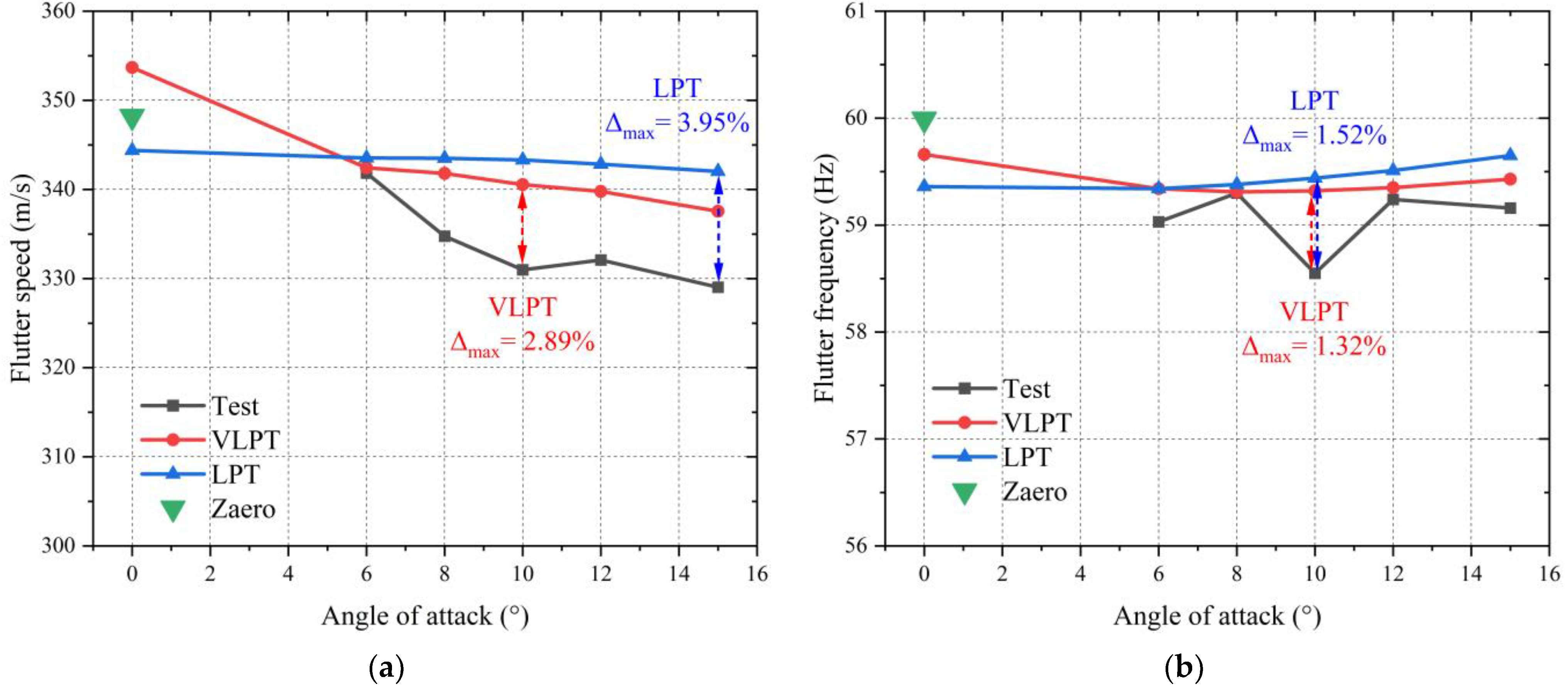
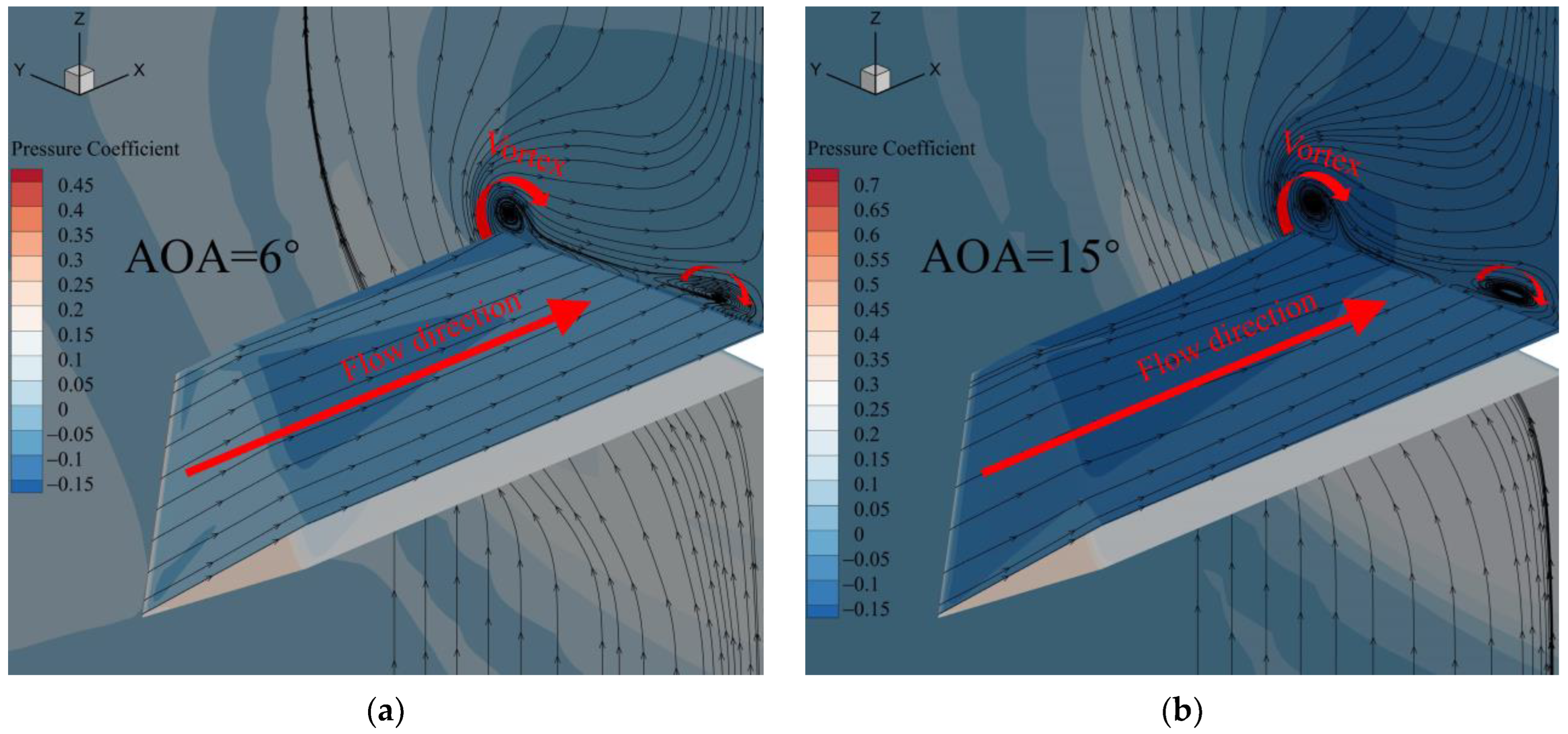
| Mass (kg) | Center of Mass (mm) | |
|---|---|---|
| X Direction | Y Direction | |
| 2.096 | 14.13 | 26.67 |
| Order | Frequency (Hz) (Error) | Modal Shape | |
|---|---|---|---|
| Test Model | FE Model | ||
| First torsion | 48.8 | 48.86 (0.12%) | 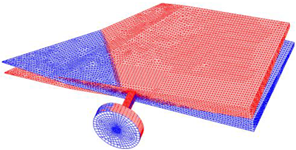 |
| First bending | 67.8 | 67.77 (−0.04%) |  |
| AOA (°) | Flutter Dynamic Pressure (kPa) | Equivalent Flutter Speed (m/s) | Flutter Frequency (Hz) |
|---|---|---|---|
| 6 | 71.57 | 341.84 | 59.03 |
| 8 | 68.64 | 334.76 | 59.30 |
| 10 | 67.10 | 330.98 | 58.55 |
| 12 | 67.55 | 332.10 | 59.24 |
| 15 | 66.31 | 329.03 | 59.16 |
| Mesh Model | Cell Number (Error) | Coefficient (Error) | |
|---|---|---|---|
| Lift | Pitching Moment | ||
| Coarse | 631,056 (26.48%) | 0.2742 (0.36%) | −0.01774 (3.58%) |
| Baseline | 2,383,356 | 0.2733 | −0.01713 |
| Fine | 9,330,400 (391.48%) | 0.2728 (−0.15%) | −0.01690 (−1.34%) |
| AOA (°) | Flutter Dynamic Pressure (kPa) | Equivalent Flutter Speed (m/s) | Flutter Frequency (Hz) |
|---|---|---|---|
| 6 | 71.82 (0.35%) | 342.43 (0.17%) | 59.34 (0.53%) |
| 8 | 71.56 (4.25%) | 341.81 (2.10%) | 59.31 (0.02%) |
| 10 | 71.03 (5.86%) | 340.54 (2.89%) | 59.32 (1.32%) |
| 12 | 70.71 (4.68%) | 339.77 (2.31%) | 59.35 (0.19%) |
| 15 | 69.79 (5.25%) | 337.55 (2.59%) | 59.43 (0.46%) |
| AOA (°) | Flutter Dynamic Pressure (kPa) | Equivalent Flutter Speed (m/s) | Flutter Frequency (Hz) |
|---|---|---|---|
| 6 | 72.28 (0.99%) | 343.52 (0.49%) | 59.34 (0.53%) |
| 8 | 72.27 (5.29%) | 343.50 (2.61%) | 59.38 (0.13%) |
| 10 | 72.19 (7.59%) | 343.31 (3.72%) | 59.44 (1.52%) |
| 12 | 71.99 (6.57%) | 342.83 (3.23%) | 59.51 (0.46%) |
| 15 | 71.65 (8.05%) | 342.02 (3.95%) | 59.65 (0.83%) |
Disclaimer/Publisher’s Note: The statements, opinions and data contained in all publications are solely those of the individual author(s) and contributor(s) and not of MDPI and/or the editor(s). MDPI and/or the editor(s) disclaim responsibility for any injury to people or property resulting from any ideas, methods, instructions or products referred to in the content. |
© 2023 by the authors. Licensee MDPI, Basel, Switzerland. This article is an open access article distributed under the terms and conditions of the Creative Commons Attribution (CC BY) license (https://creativecommons.org/licenses/by/4.0/).
Share and Cite
Liu, C.; Xie, C.; Meng, Y.; Bai, L. Experimental and Numerical Flutter Analysis Using Local Piston Theory with Viscous Correction. Aerospace 2023, 10, 870. https://doi.org/10.3390/aerospace10100870
Liu C, Xie C, Meng Y, Bai L. Experimental and Numerical Flutter Analysis Using Local Piston Theory with Viscous Correction. Aerospace. 2023; 10(10):870. https://doi.org/10.3390/aerospace10100870
Chicago/Turabian StyleLiu, Chenyu, Changchuan Xie, Yang Meng, and Liuyue Bai. 2023. "Experimental and Numerical Flutter Analysis Using Local Piston Theory with Viscous Correction" Aerospace 10, no. 10: 870. https://doi.org/10.3390/aerospace10100870






